Local Seismic Effects Responsible for Differentiated Damages in Historical City Centers: The Case Study of San Giustino’s Square (Chieti, Italy)
Abstract
1. Introduction
2. Geological, Litho-Technical, and Seismic–Tectonic Features of Chieti

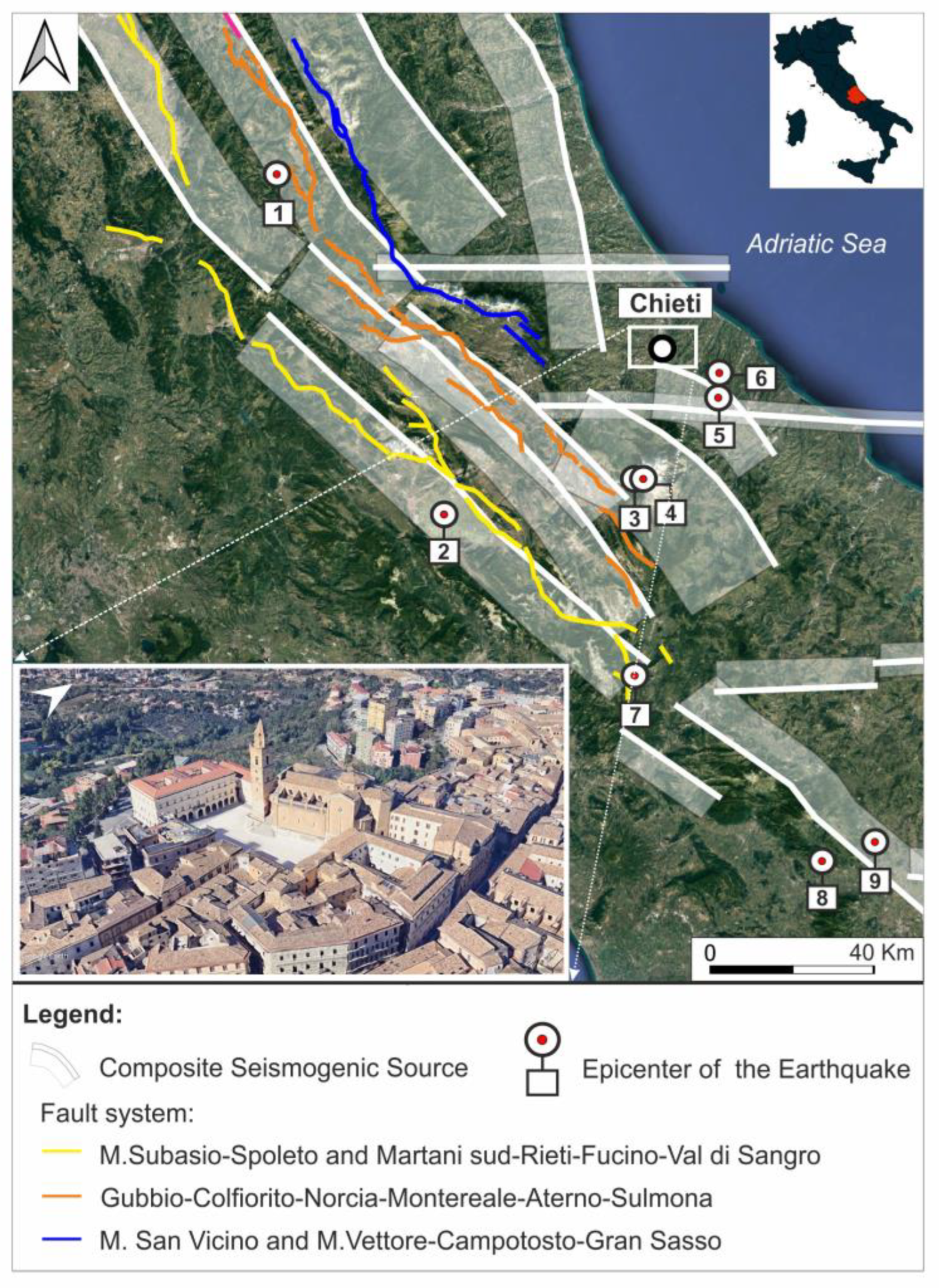
3. Damages Suffered in San Giustino’s Square After the 2009 L’Aquila Earthquake
4. Subsurface Characterization of San Giustino’s Square
4.1. Geognostic Soundings
- Anthropogenic soil deposits (RI);
- Altered sandy horizon of yellow silty sand attributable to the sandy-conglomeratic association of the Mutignano Formation (FMTd);
- Greenish loamy–clayey fine-grained soil (FMTd-1) (this layer is a fine pelitic stratum sedimented within the sandy–conglomeratic association of the Mutignano Formation [49]);
- Dense yellow sand attributable to the sandier member of the Mutignano Formation (FMTc);
- Pliocene clayey substrate (FMTa) consisting of grey-blue clay with greyish sandy levels.
4.2. Geophysical Investigations
4.2.1. Seismic Refraction
4.2.2. Georadar
4.2.3. Geoelectrical Survey
5. Two-Dimensional Numerical Model of San Giustino’s Square
5.1. Finite Element Simulations
5.2. Input Motion Used for the Numerical Analysis
5.3. Two-Dimensional Numerical Model: Mesh and Subsoil Properties Assigned
6. Results
- The mean Acceleration Response Spectra (SA) calculated on the surface at each selected point (Figure 14) as a result of the average spectrum of the seven input signals;
- The FA according to Equation (9).
7. Conclusions
- (1)
- The Justice Court suffered an amplification of FA equal to 2.4 in the period range 0.1–0.5 s. The spectral acceleration amplified periods correspond to the range of estimated fundamental periods 0.36–0.5 s.
- (2)
- The presence of a shallow cavity (L = 11 m and H = 8 m) moves away from its axis, the most amplified area at a distance equal to 1.5 L. Nonetheless, the nearby buildings of the Cathedral and the Former Town Hall were not affected by this amplification.
- (3)
- The LSR results indicated that the soft anthropogenic layer of roughly 10 m is the most significant contributor to the high FA across San Giustino’s Square, even though Chieti’s Hillcrest, close to the Justice Court, contributed to amplify the period range 0.1–0.5 s within which the fundamental periods of the Justice Court building fall.
Author Contributions
Funding
Data Availability Statement
Acknowledgments
Conflicts of Interest
References
- Vessia, G.; Rainone, M.L.; De Santis, A.; D’Elia, G. Lessons from April 6, 2009 L’Aquila Earthquake to Enhance Microzoning Studies in near-Field Urban Areas. Geoenviron. Disasters 2020, 7, 11. [Google Scholar] [CrossRef]
- Vessia, G.; Laurenzano, G.; Pagliaroli, A.; Pilz, M. Seismic Site Response Estimation for Microzonation Studies Promoting the Resilience of Urban Centers. Eng. Geol. 2021, 284, 106031. [Google Scholar] [CrossRef]
- Primofiore, I.; Baron, J.; Klin, P.; Laurenzano, G.; Muraro, C.; Capotorti, F.; Amanti, M.; Vessia, G. 3D Numerical Modelling for Interpreting Topographic Effects in Rocky Hills for Seismic Microzonation: The Case Study of Arquata Del Tronto Hamlet. Eng. Geol. 2020, 279, 105868. [Google Scholar] [CrossRef]
- Faraone, C.; Colantonio, F.; Vessia, G. Seismic Amplification Effects Induced by Ancient Shallow Cavities underneath the Urban Area of the Historical City Center of Chieti, Italy. Eng. Geol. 2023, 324, 107259. [Google Scholar] [CrossRef]
- Solakov, D.E.; Stefanov, D.; Simeonova, S.; Raykova-Tsankova, P. Seismic Risk Assessment for the City of Sofia, Bulgaria. Geosciences 2024, 14, 307. [Google Scholar] [CrossRef]
- Hakimov, F.; Havenith, H.-B.; Ischuk, A.; Reicherter, K. Assessment of Site Effects and Numerical Modeling of Seismic Ground Motion to Support Seismic Microzonation of Dushanbe City, Tajikistan. Geosciences 2024, 14, 117. [Google Scholar] [CrossRef]
- Amato, V.; Covolan, M.; Dessales, H.; Santoriello, A. Seismic Microzonation of the Pompeii Archaeological Park (Southern Italy): Local Seismic Amplification Factors. Geosciences 2022, 12, 275. [Google Scholar] [CrossRef]
- Graziani, L.; del Mese, S.; Tertulliani, A.; Arcoraci, L.; Maramai, A.; Rossi, A. Investigation on Damage Progression during the 2016–2017 Seismic Sequence in Central Italy Using the European Macroseismic Scale (EMS-98). Bull. Earthq. Eng. 2019, 17, 5535–5558. [Google Scholar] [CrossRef]
- Chávez-García, F.J.; Monsalve Jaramillo, H.; Gómez Cano, M.; Vila Ortega, J.J. Vulnerability and Site Effects in Earthquake Disasters in Armenia (Colombia). I—Site Effects. Geosciences 2018, 8, 254. [Google Scholar] [CrossRef]
- Panzera, F.; Lombardo, G.; Imposa, S.; Grassi, S.; Gresta, S.; Catalano, S.; Romagnoli, G.; Tortorici, G.; Patti, F.; Di Maio, E. Correlation between Earthquake Damage and Seismic Site Effects: The Study Case of Lentini and Carlentini, Italy. Eng. Geol. 2018, 240, 149–162. [Google Scholar] [CrossRef]
- Rainieri, C.; Fabbrocino, G. Estimating the Elastic Period of Masonry Towers. In Topics in Modal Analysis I, Volume 5: Proceedings of the 30th IMAC, A Conference on Structural Dynamics, 2012; Allemang, R., De Clerck, J., Niezrecki, C., Blough, J.R., Eds.; Springer: New York, NY, USA, 2012; pp. 243–248. [Google Scholar]
- D.M. 14/01/2008; Norme Tecniche per le Costruzioni (NTC08). Superior Council of Public Works, C.S. Official Gazette: Rome, Italy, 2008. (In Italian)
- Faccio, P.; Podestà, S.; Saetta, A. Venezia, Campanile Della Chiesa Di Sant’Antonin, Esempio 5, in Linee Guida per La Valutazione e Riduzione Del Rischio Sismico Del Patrimonio Culturale Allineate Alle Nuove Norme Tecniche per Le Costruzioni (D.M. 14/01/2008). Circolare 2011, 26, 2010. (In Italian) [Google Scholar]
- Doğangün, A.; Sezen, H. Seismic Vulnerability and Preservation of Historical Masonry Monumental Structures. Earthq. Struct. 2012, 3, 83–95. [Google Scholar] [CrossRef]
- Fayjaloun, R.; Negulescu, C.; Roullé, A.; Auclair, S.; Gehl, P.; Faravelli, M. Sensitivity of Earthquake Damage Estimation to the Input Data (Soil Characterization Maps and Building Exposure): Case Study in the Luchon Valley, France. Geosciences 2021, 11, 249. [Google Scholar] [CrossRef]
- Vessia, G.; Russo, S. Relevant Features of the Valley Seismic Response: The Case Study of Tuscan Northern Apennine Sector. Bull. Earthq. Eng. 2013, 11, 1633–1660. [Google Scholar] [CrossRef]
- Boncio, P.; Amoroso, S.; Vessia, G.; Francescone, M.; Nardone, M.; Monaco, P.; Famiani, D.; Di Naccio, D.; Mercuri, A.; Manuel, M.R.; et al. Evaluation of Liquefaction Potential in an Intermountain Quaternary Lacustrine Basin (Fucino Basin, Central Italy). Bull. Earthq. Eng. 2018, 16, 91–111. [Google Scholar] [CrossRef]
- Faraone, C.; Caravaggio, S.; Chávez, J.A.; Castillo Ramos, L.A.; Rainone, M.L.; Vessia, G. 2D FEM Numerical Prediction of Local Seismic Effects at San Salvador Municipality (El Salvador) Induced by 2001 Earthquakes. Geosciences 2023, 13, 116. [Google Scholar] [CrossRef]
- Evangelista, L.; Landolfi, L.; d’Onofrio, A.; Silvestri, F. The Influence of the 3D Morphology and Cavity Network on the Seismic Response of Castelnuovo Hill to the 2009 Abruzzo Earthquake. Bull. Earthq. Eng. 2016, 14, 3363–3387. [Google Scholar] [CrossRef]
- Zhang, Z.; Fleurisson, J.-A.; Pellet, F.L. A Case Study of Site Effects on Seismic Ground Motions at Xishan Park Ridge in Zigong, Sichuan, China. Eng. Geol. 2018, 243, 308–319. [Google Scholar] [CrossRef]
- Moczo, P.; Kristek, J.; Bard, P.-Y.; Stripajová, S.; Hollender, F.; Chovanová, Z.; Kristeková, M.; Sicilia, D. Key Structural Parameters Affecting Earthquake Ground Motion in 2D and 3D Sedimentary Structures. Bull. Earthq. Eng. 2018, 16, 2421–2450. [Google Scholar] [CrossRef]
- Ge, Z. Simulation of the Seismic Response of Sedimentary Basins with Constant-Gradient Velocity along Arbitrary Direction Using Boundary Element Method: SH Case. Earthq. Sci. 2010, 23, 149–155. [Google Scholar] [CrossRef]
- Semblat, J.F.; Duval, A.M.; Dangla, P. Seismic Site Effects in a Deep Alluvial Basin: Numerical Analysis by the Boundary Element Method. Comput. Geotech. 2002, 29, 573–585. [Google Scholar] [CrossRef]
- Álvarez-Rubio, S.; Benito, J.J.; Sánchez-Sesma, F.J.; Alarcón, E. The Use of Direct Boundary Element Method for Gaining Insight into Complex Seismic Site Response. Comput. Struct. 2005, 83, 821–835. [Google Scholar] [CrossRef]
- Chen, Z.; Huang, D.; Wang, G. A Regional Scale Coseismic Landslide Analysis Framework: Integrating Physics-Based Simulation with Flexible Sliding Analysis. Eng. Geol. 2023, 315, 107040. [Google Scholar] [CrossRef]
- Smerzini, C.; Vanini, M.; Paolucci, R.; Renault, P.; Traversa, P. Regional Physics-Based Simulation of Ground Motion within the Rhȏne Valley, France, during the MW 4.9 2019 Le Teil Earthquake. Bull. Earthq. Eng. 2023, 21, 1747–1774. [Google Scholar] [CrossRef]
- Ricci, A.; Romanelli, F.; Vaccari, F.; Boncio, P.; Venisti, N.; Faraone, C.; Vessia, G.; Panza, G.F. Comparison between the Neo-Deterministic Seismic Hazard and FEM Approach to Assessing 2D Local Seismic Response at Chieti’s City Site (Abruzzo, Italy). Eng. Geol. 2025, 347, 107891. [Google Scholar] [CrossRef]
- Gatmiri, B.; Arson, C.; Nguyen, K.V. Seismic Site Effects by an Optimized 2D BE/FE Method I. Theory, Numerical Optimization and Application to Topographical Irregularities. Soil Dyn. Earthq. Eng. 2008, 28, 632–645. [Google Scholar] [CrossRef]
- Brando, G.; Pagliaroli, A.; Cocco, G.; Di Buccio, F. Site Effects and Damage Scenarios: The Case Study of Two Historic Centers Following the 2016 Central Italy Earthquake. Eng. Geol. 2020, 272, 105647. [Google Scholar] [CrossRef]
- Grünthal, G. European Macroseismic Scale 1998—EMS98; Cahiers Du Centre Européen de Géodynamique et de Séismologie 15; Centre Européen de Géodynamique et de Séismologie: Luxembourg, 1998. [Google Scholar]
- Mancini, F.; D’Amico, S.; Vessia, G. Are Synthetic Accelerograms Suitable for Local Seismic Response Analyses at Near-Field Sites? Bull. Seismol. Soc. Am. 2021, 112, 992–1007. [Google Scholar] [CrossRef]
- Mancini, F. Definizione di Input Sintetici Nello Studio di Risposta Sismica Locale del Comune di Cortino (TE). Master’s Thesis, Università degli Studi Gabriele d’Annunzio, Chieti, Italy, 2018. [Google Scholar]
- Chieffo, N.; Formisano, A. Induced Seismic-Site Effects on the Vulnerability Assessment of a Historical Centre in the Molise Region of Italy: Analysis Method and Real Behaviour Calibration Based on 2002 Earthquake. Geosciences 2020, 10, 21. [Google Scholar] [CrossRef]
- Kottke, A.R.; Wang, X.; Rathje, E.M. Technical Manual of STRATA Geotechnical Engineering Center; University of Texas: Austin, TX, USA, 2013. [Google Scholar]
- Agostini, S. The Stratified Growth of Chieti from Roman Times to Tomorrow: A New, Geolo-Gy-Based Conscience in City Planning and Renewal. Alp. Mediterr. Quat. 2018, 31, 195–205. [Google Scholar] [CrossRef]
- Boncio, P.; Lavecchia, G.; Pace, B. Defining a Model of 3D Seismogenic Sources for Seismic Hazard Assessment Applications: The Case of Central Apennines (Italy). J. Seismol. 2004, 8, 407–425. [Google Scholar] [CrossRef]
- D’Agostino, N. Complete Seismic Release of Tectonic Strain and Earthquake Recurrence in the Apennines (Italy). Geophys. Res. Lett. 2014, 41, 1155–1162. [Google Scholar] [CrossRef]
- DISS Working Group. Database of Individual Seismogenic Sources (DISS), Version 3.3.0: A 759 Compilation of Potential Sources for Earthquakes Larger than M 5.5 in Italy and Surrounding Areas; Istituto 760 Nazionale Di Geofisica e Vulcanologia (INGV): Rome, Italy, 2021. [Google Scholar]
- Galli, P. Recurrence Times of Central-Southern Apennine Faults (Italy): Hints from Palaeoseismology. Terra Nova 2020, 32, 399–407. [Google Scholar] [CrossRef]
- Faure Walker, J.; Boncio, P.; Pace, B.; Roberts, G.; Benedetti, L.; Scotti, O.; Visini, F.; Peruzza, L. Fault2SHA Central Apennines Database and Structuring Active Fault Data for Seismic Hazard Assessment. Sci. Data 2021, 8, 87. [Google Scholar] [CrossRef]
- Rossetti, E.; Mazzei, A. Progetto di Microzonazione Sismica di Livello 1 del Comune di Chieti (CH)—(Indagini e Relazione Illustrativa), Chieti, Italy, 2015.
- Boncio, P.; Lavecchia, G. A Structural Model for Active Extension in Central Italy. J. Geodyn. 2000, 29, 233–244. [Google Scholar] [CrossRef]
- Rovida, A.; Locati, M.; Camassi, R.; Lolli, B.; Gasperini, P. The Italian Earthquake Catalogue CPTI15. Bull. Earthq. Eng. 2020, 18, 2953–2984. [Google Scholar] [CrossRef]
- Locati, M.; Camassi, R.; Rovida, A.; Ercolani, E.; Bernardini, F.; Castelli, V.; Caracciolo, C.H.; Tertulliani, A.; Rossi, A.; Azzaro, R.; et al. DBMI15, Versione 4.0. Database Macrosismico Italiano. Istituto Nazionale Di Geofisica e Vulcanologia (INGV): Rome, Italy, 2022.
- Galli, P.; Camassi, R. Rapporto Sugli Effetti del Terremoto Aquilano del 6 Aprile 2009; INGV: Rome, Italy, 2009. [Google Scholar] [CrossRef]
- De Deo, F.; Di Renzo, W. Riattazione e Miglioramento Sismico Della Sede Del Tribunale Di Chieti—Progetto Preliminare—Verifiche Di Vulnerabilità Sismica (A2), Chieti, Italy, 2010. (In Italian)
- ChietiToday. Decennale Del Terremoto Dell’Aquila: Le Vittime Della Provincia Di Chieti e i Danni in Città; ChietiToday: Chieti, Italy, 2019. [Google Scholar]
- Colantonio, F. Progetto di Riqualificazione Urbana e Sicurezza Delle Periferie “Ambito di Intervento A2 Riqualificazione Architettonica di Piazza San Giustino”—Relazione Geologica e Modellazione Sismica, Chieti, Italy, 2018. (In Italian)
- ISPRA. Note Illustrative Della Carta Geologica d’Italia Alla Scala 1:50.000. Foglio 361 Chieti; Istituto Superiore per la Protezione e la Ricerca Ambientale: Roma, Italy, 2010. (In Italian) [Google Scholar]
- Faraone, C. Valutazione Degli Effetti di Cavità Antropiche Nella Riposta Sismica Locale in Aree Urbane Della Città di Chieti. Master’s Thesis, Università degli Studi Gabriele d’Annunzio, Chieti, Italy, 2020. [Google Scholar]
- Azwin, I.N.; Saad, R.; Nordiana, M. Applying the Seismic Refraction Tomography for Site Characterization. APCBEE Procedia 2013, 5, 227–231. [Google Scholar] [CrossRef]
- Gizzi, F.T.; Loperte, A.; Satriani, A.; Lapenna, V.; Masini, N.; Proto, M. Georadar Investigations to Detect Cavities in a Historical Town Damaged by an Earthquake of the Past. Adv. Geosci. 2010, 24, 15–21. [Google Scholar] [CrossRef][Green Version]
- Metwaly, M.; AlFouzan, F. Application of 2-D Geoelectrical Resistivity Tomography for Subsurface Cavity Detection in the Eastern Part of Saudi Arabia. Geosci. Front. 2013, 4, 469–476. [Google Scholar] [CrossRef]
- Hussain, Y.; Uagoda, R.; Borges, W.; Nunes, J.; Hamza, O.; Condori, C.; Aslam, K.; Dou, J.; Cárdenas-Soto, M. The Potential Use of Geophysical Methods to Identify Cavities, Sinkholes and Pathways for Water Infiltration. Water 2020, 12, 2289. [Google Scholar] [CrossRef]
- Putiška, R.; Nikolaj, M.; Dostál, I.; Kušnirák, D. Determination of Cavities Using Electrical Resistivity Tomography. Contrib. Geophys. Geod. 2012, 42, 201–211. [Google Scholar] [CrossRef]
- AlgoShake2D, v. 1.1.5. Software Agli Elementi Finiti per Analisi Di Risposta Sismica Locale 2D. Algoritmiqa s.r.l.: Sellia Marina, Italy, 2024.
- Kramer, S.L. Geotechnical Earthquake Engineering; Prentice Hall International Series: Hoboken, NJ, USA, 1996; ISBN 0-13-374943-6. [Google Scholar]
- Smith, W.D. The Application of Finite Element Analysis to Body Wave Propagation Problems. Geophys. J. Int. 1975, 42, 747–768. [Google Scholar] [CrossRef]
- SM Working Group. Guidelines for Seismic Microzonation. Conference of Regions and Autonomous Provinces of Italy, Civil Protection Department, Rome (original italian edition: Gruppo di lavoro MS, Indirizzi e Criteri per la Microzonazione Sismica, Conferenza delle Regioni e delle Province autonome—Dipartimento della protezione civile, Roma, 2008), 3. 2008. [Google Scholar]
- Iervolino, I.; Galasso, C.; Paolucci, R.; Pacor, F. Engineering Ground Motion Record Selection in the ITalian ACcelerometric Archive. Bull. Earthq. Eng. 2011, 9, 1761–1778. [Google Scholar] [CrossRef]
- Stucchi, M.; Meletti, C.; Montaldo, V.; Crowley, H.; Calvi, G.M.; Boschi, E. Seismic Hazard Assessment (2003–2009) for the Italian Building Code. Bull. Seismol. Soc. Am. 2011, 101, 1885–1911. [Google Scholar] [CrossRef]
- De Vito, S.; Maffei, A.; Bonifazi, M.; Colantonio, F. Realizzazione di un Parcheggio Multipiano in Piazza Carafa a Chieti Scalo e di un Parcheggio Multipiano in via Ciampoli, V Settore—Lavori Pubblici; Chieti, Italy, 2023. (In Italian)
- Gaudiosi, I.; Romagnoli, G.; Albarello, D.; Fortunato, C.; Imprescia, P.; Stigliano, F.; Moscatelli, M. Shear Modulus Reduction and Damping Ratios Curves Joined with Engineering Geological Units in Italy. Sci. Data 2023, 10, 625. [Google Scholar] [CrossRef]
- Amoroso, S.; Totani, F.; Totani, G. Site Characterization by Seismic Dilatometer (SDMT): The Justice Court of Chieti. In Proceedings of the 18th International Conference on Soil Mechanics and Geotechnical Engineering (18th ISCMGE), Paris, France, 2–6 September 2013; Volume 1, pp. 483–486. [Google Scholar]
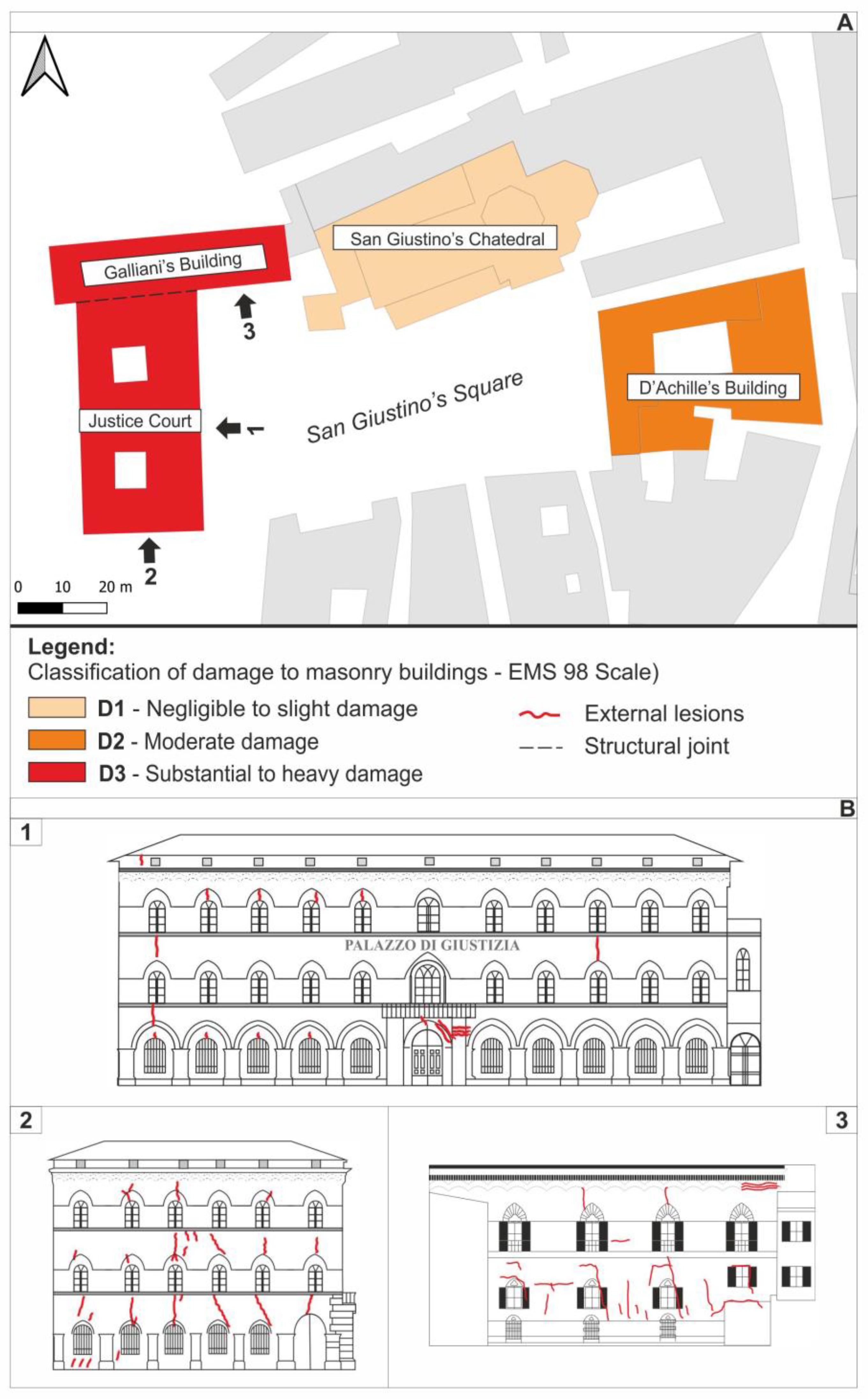


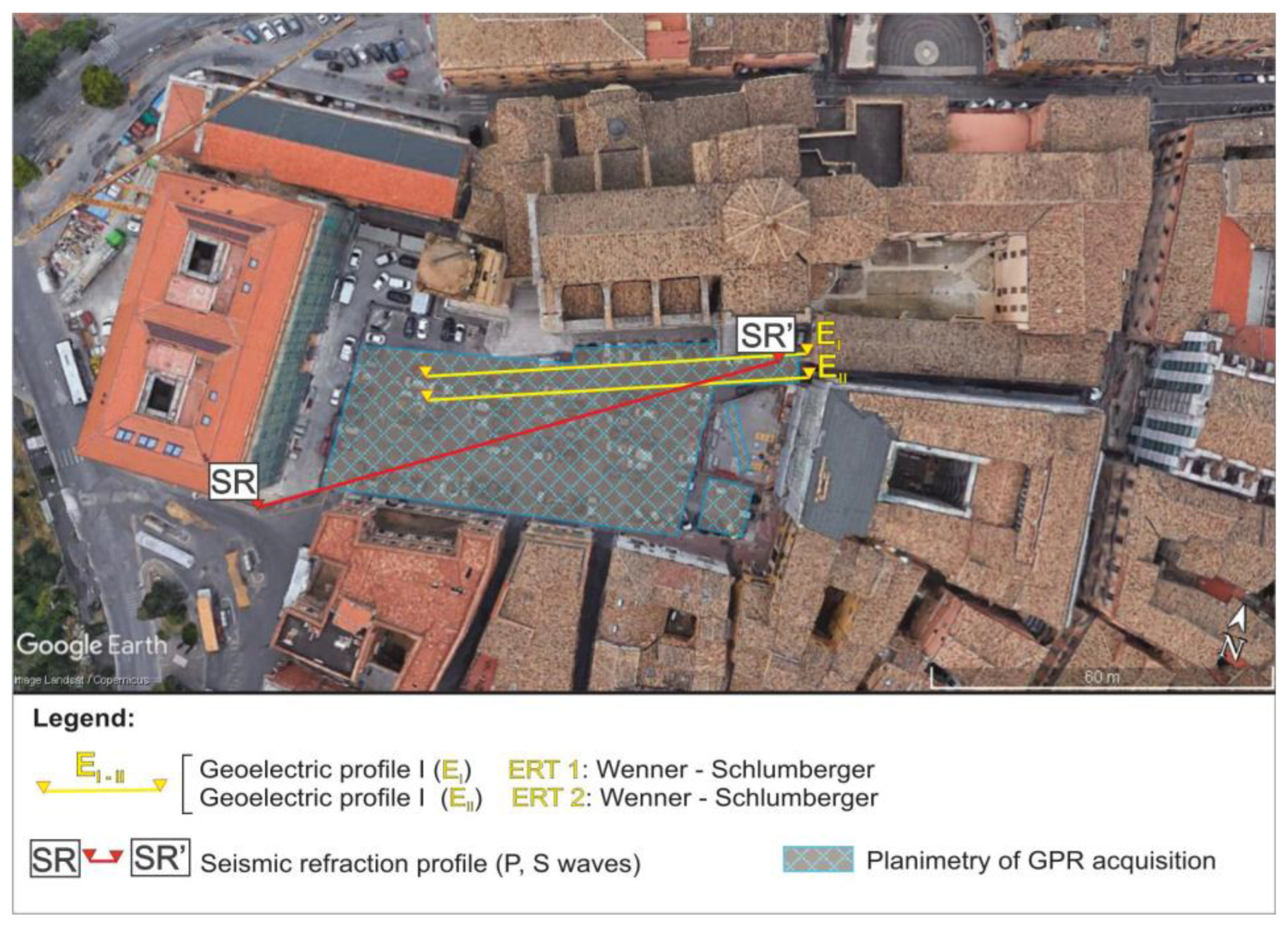
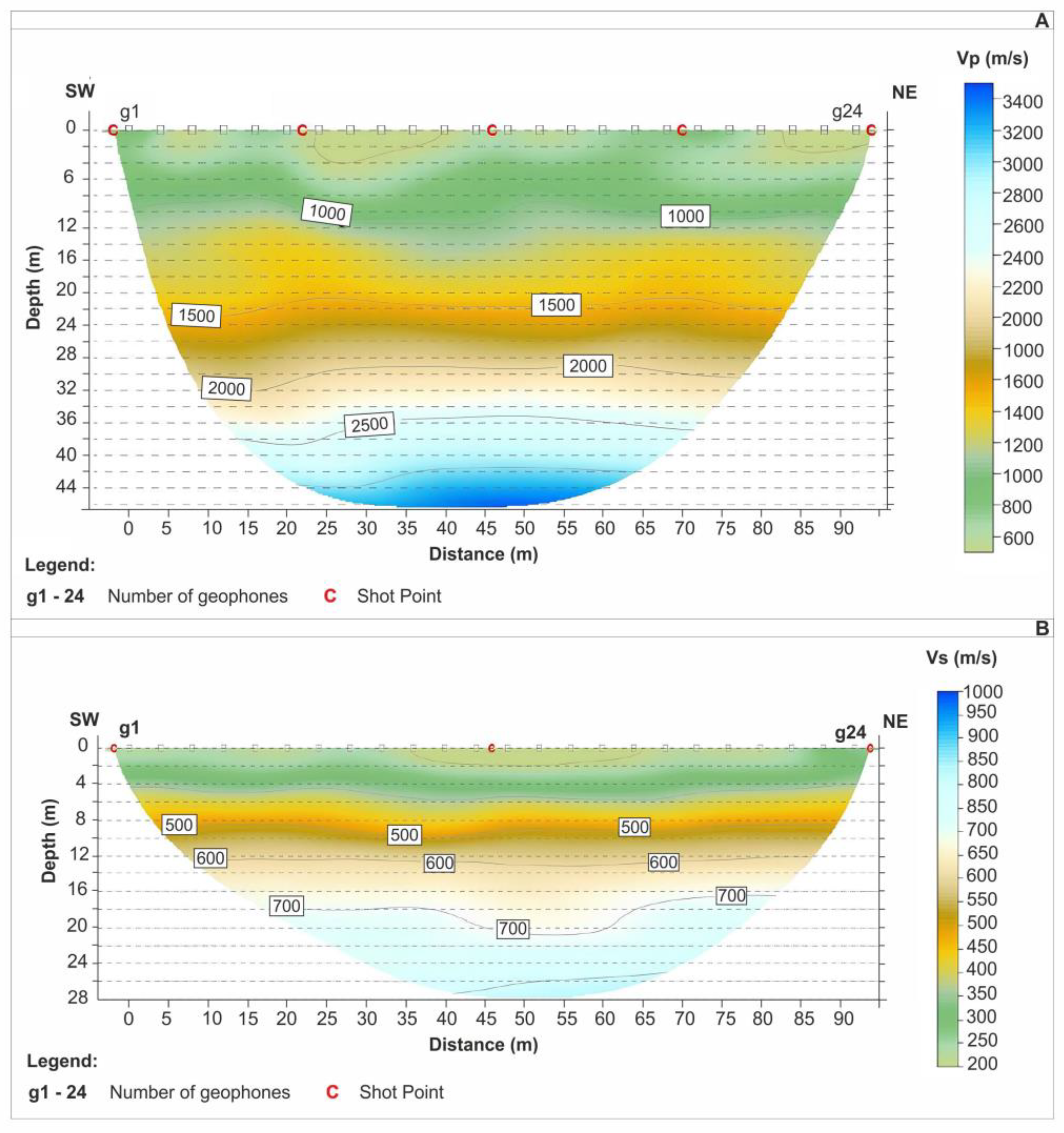

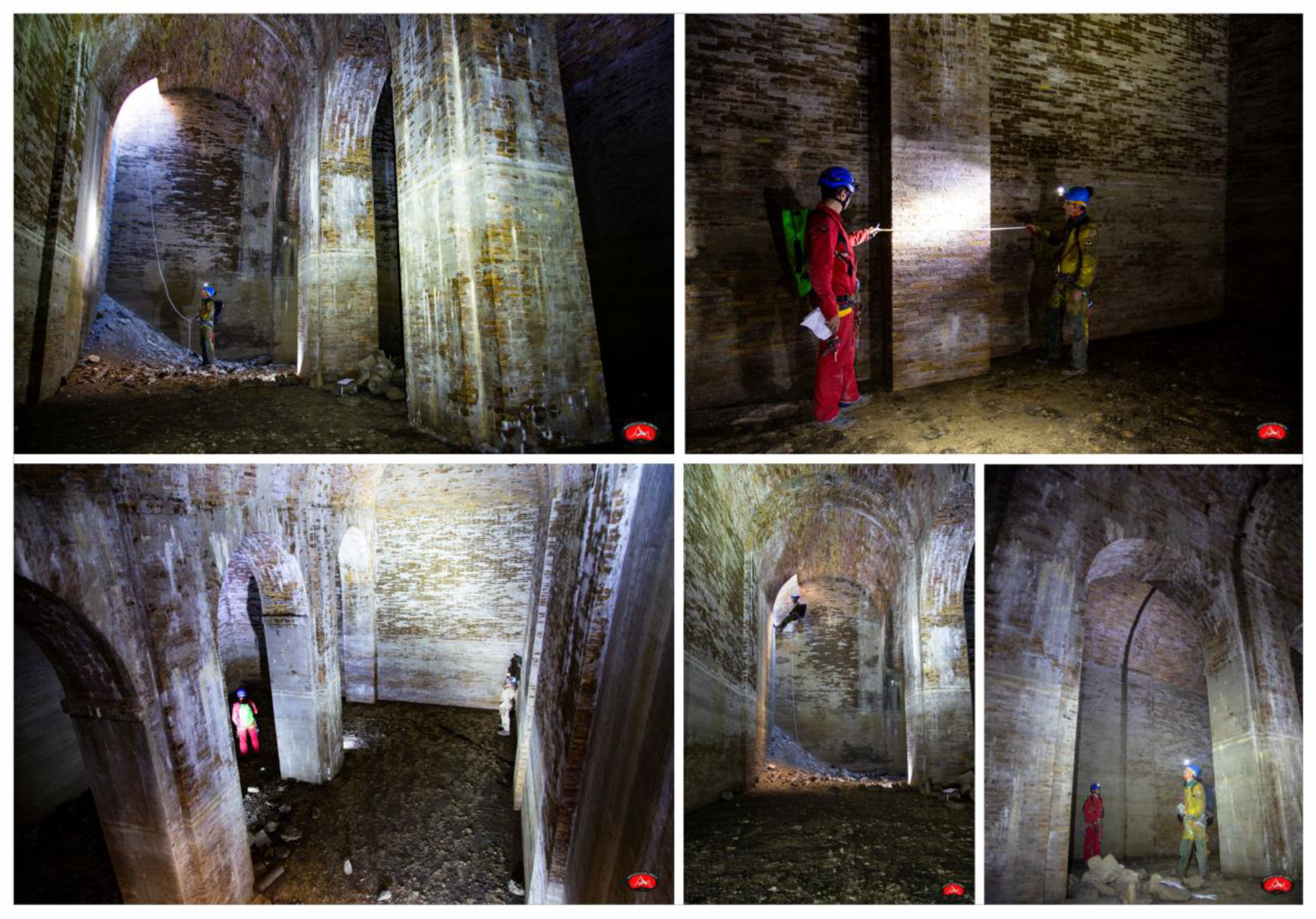
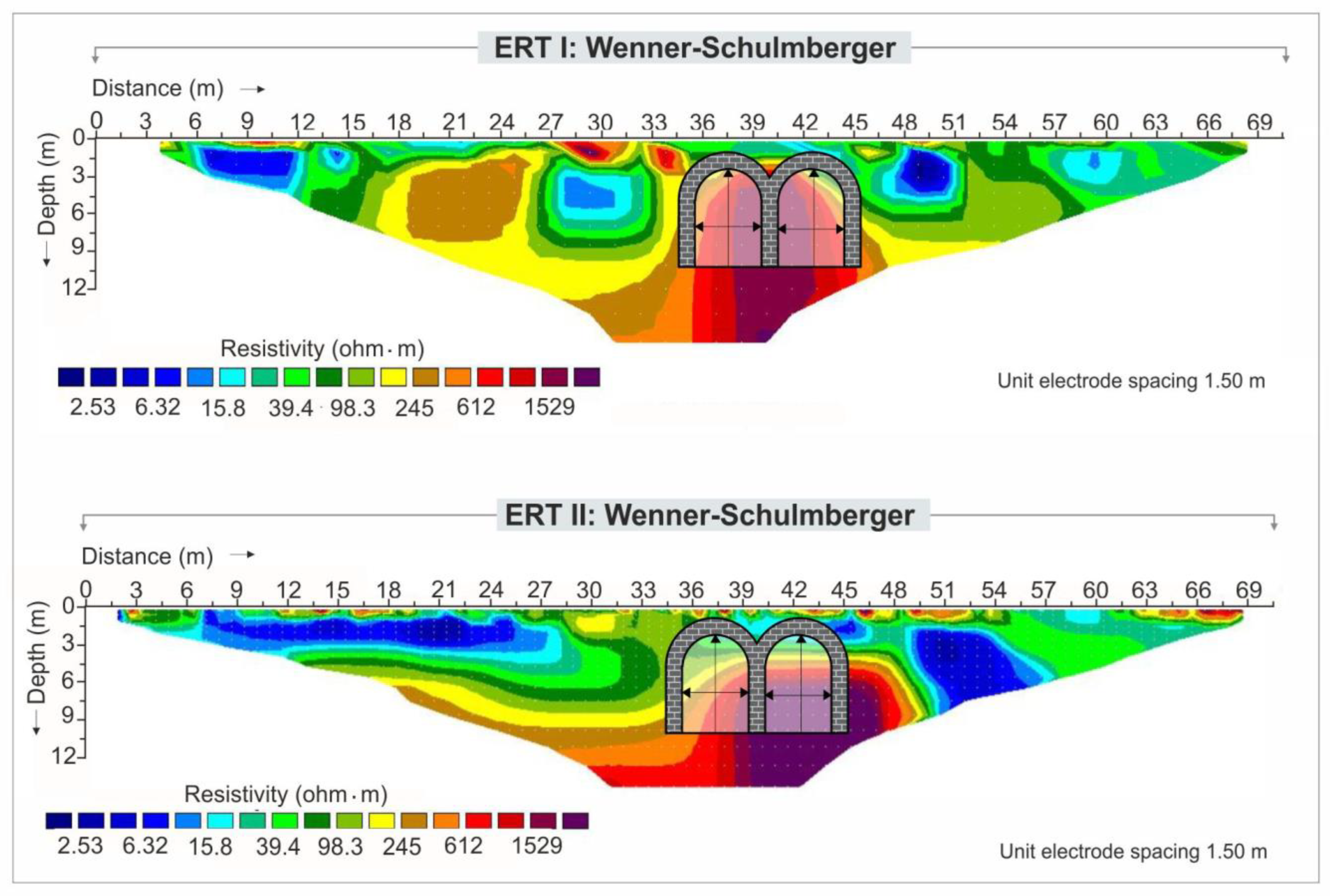
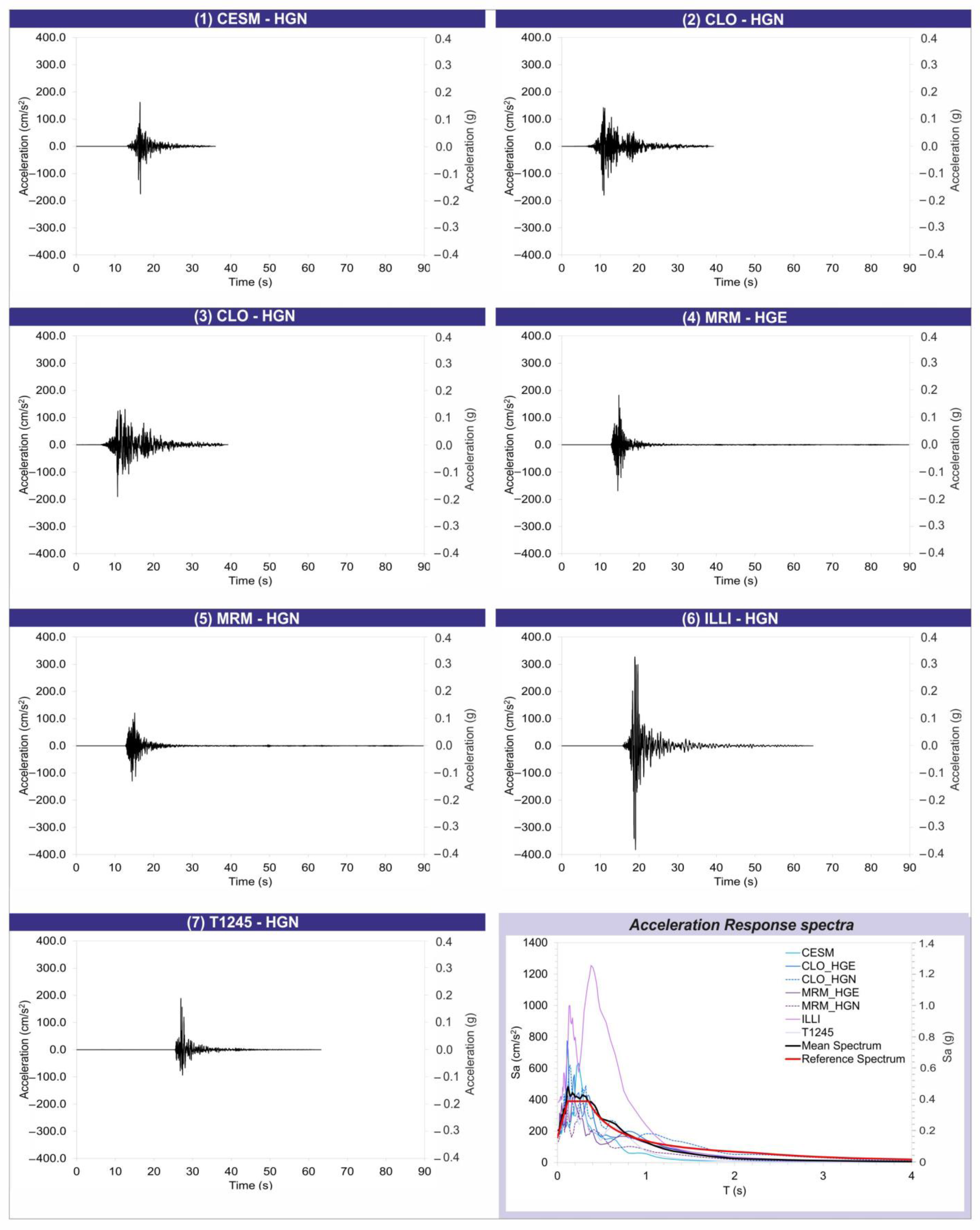

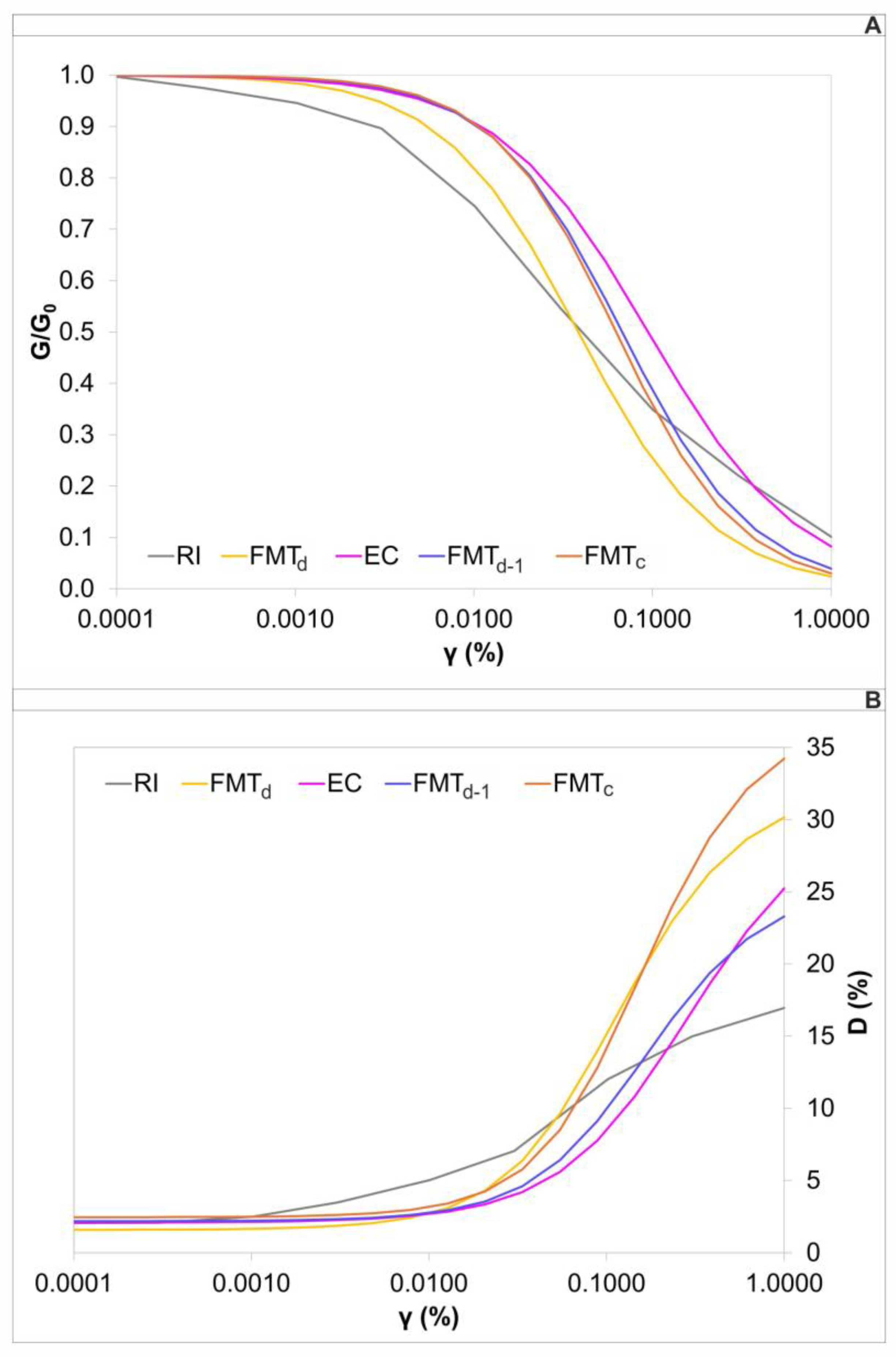
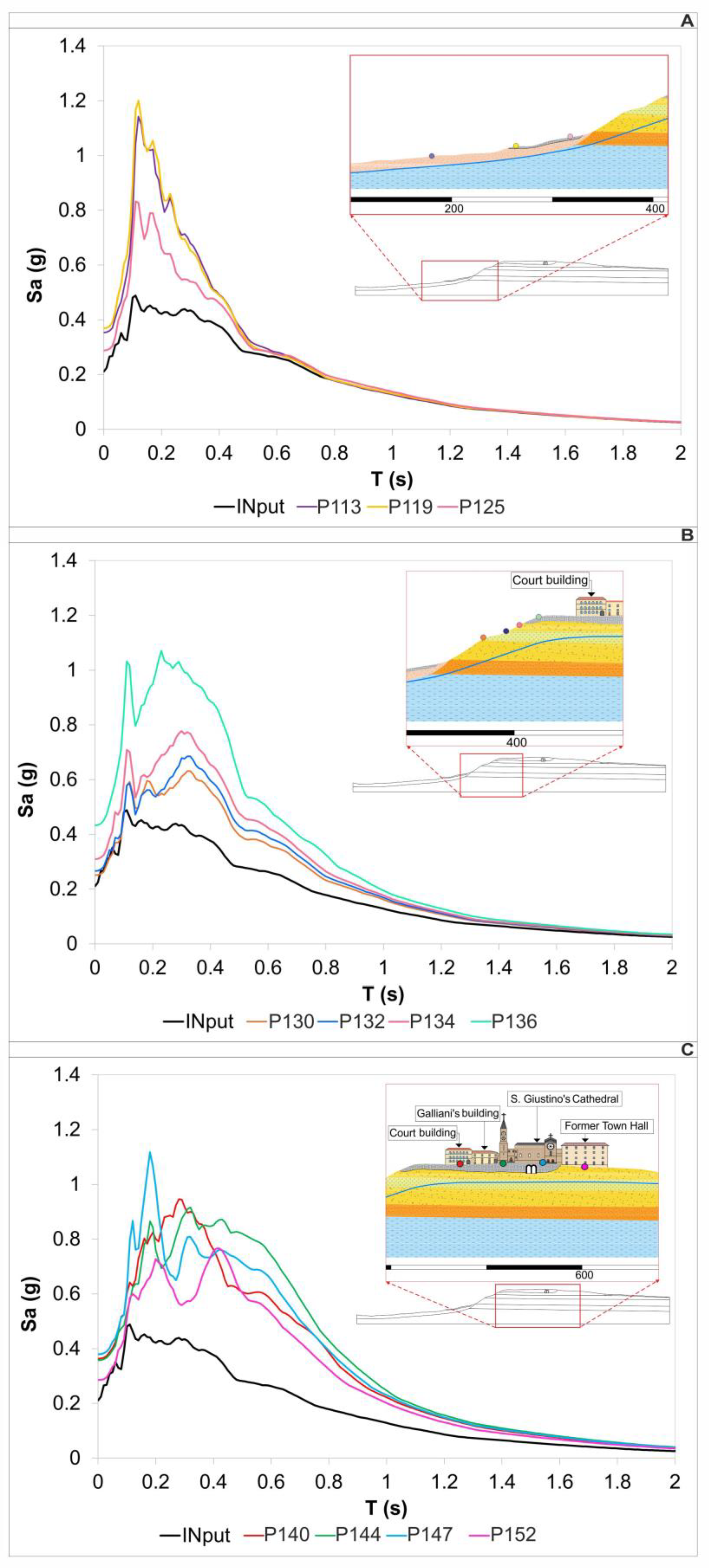
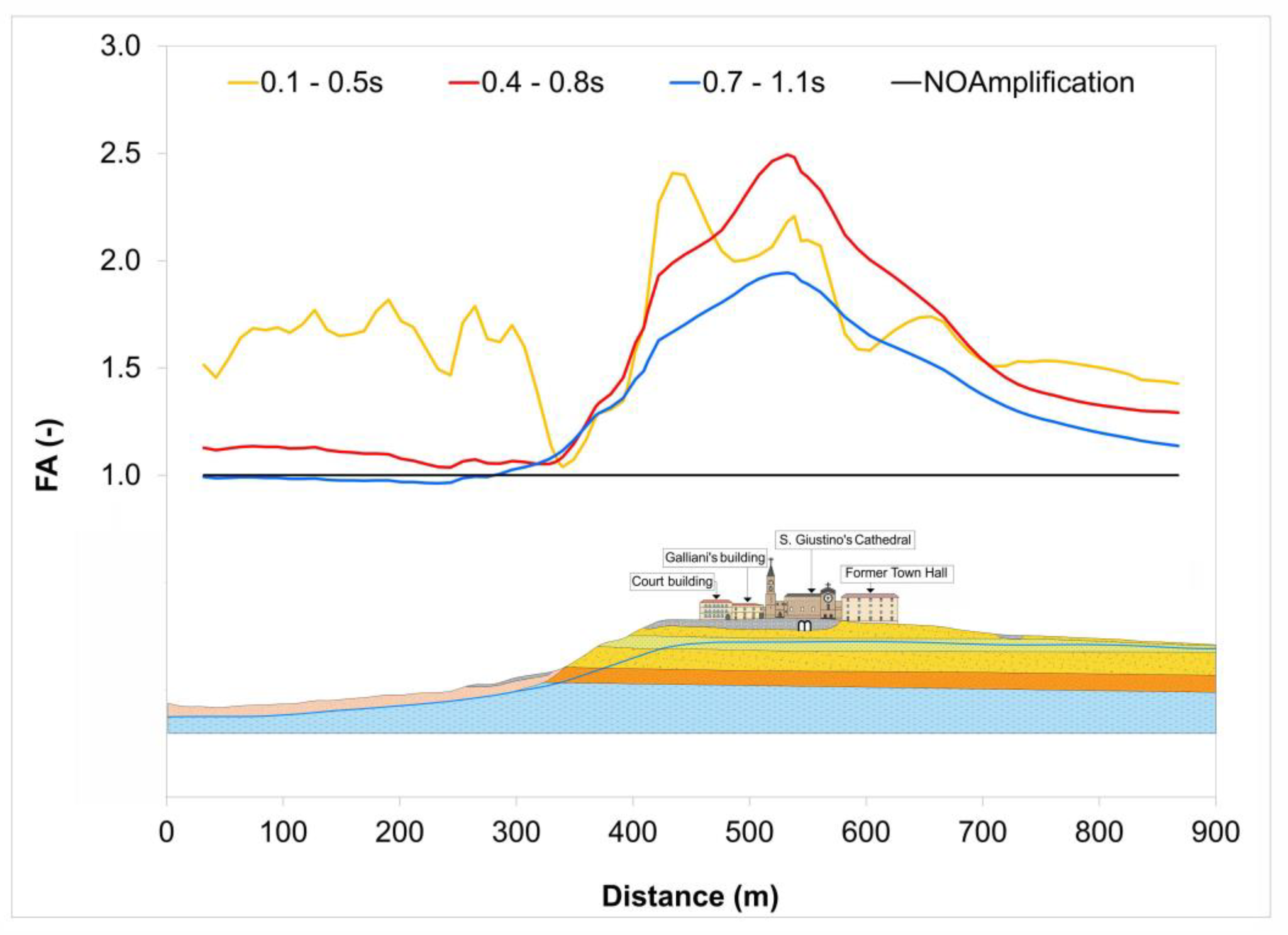
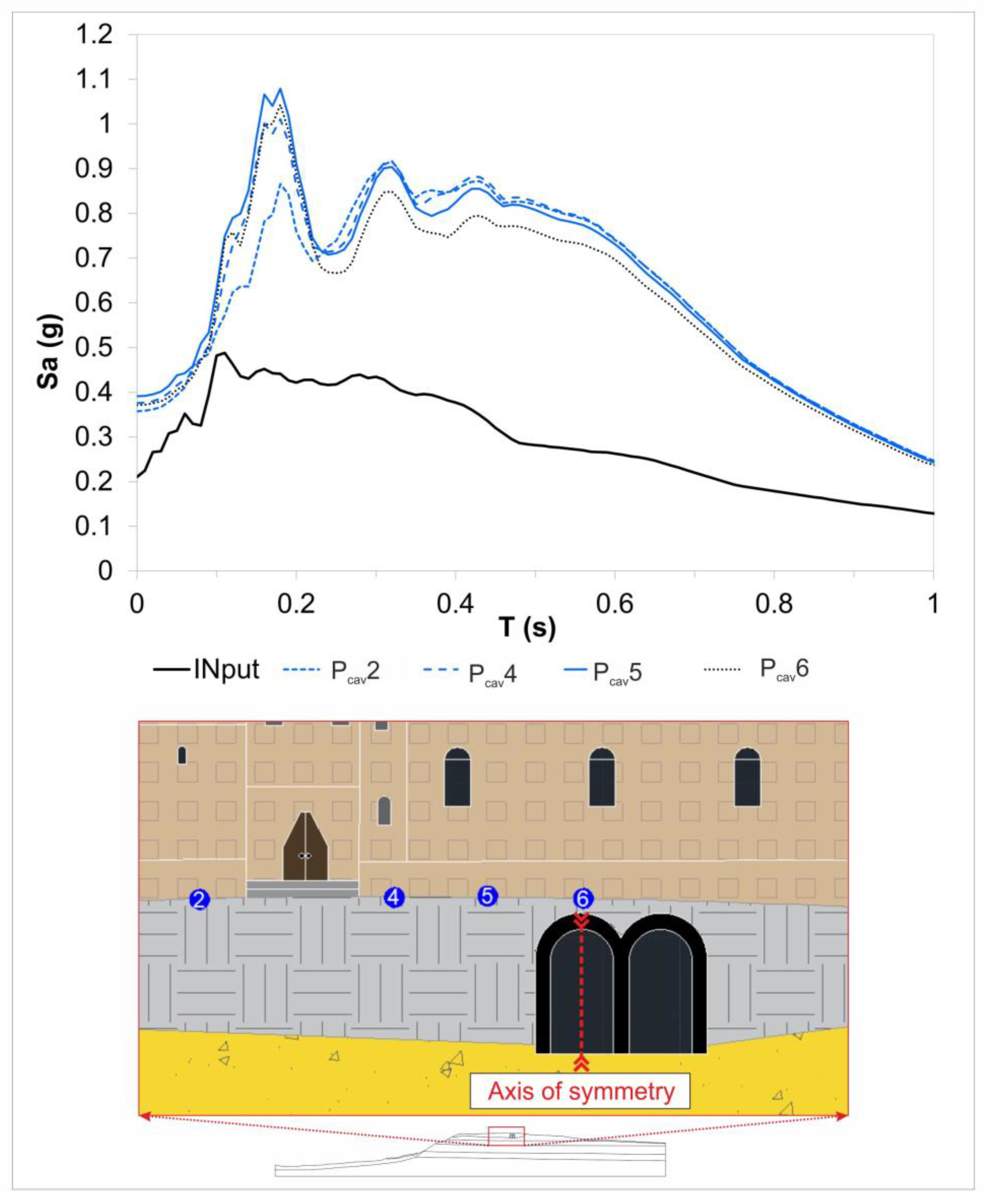
| N° | Date | Epicentral Area | Lat. (°) | Long (°) | Mw | SI * |
|---|---|---|---|---|---|---|
| 1 | 5 December 1456 | Central-Southern Apennine | 41.302 | 14.711 | 7.2 | VI |
| 2 | 5 June 1688 | Sannio | 41.283 | 14.561 | 7.1 | VI |
| 3 | 14 January 1703 | Valnerina | 42.708 | 13.071 | 7.0 | VII |
| 4 | 3 November 1706 | Maiella | 42.076 | 14.08 | 6.8 | VIII |
| 5 | 10 September 1881 | Chietino | 42.237 | 14.335 | 5.4 | VI |
| 6 | 12 February 1882 | Chietino | 42.291 | 14.347 | 5.3 | VII |
| 7 | 13 January 1915 | Marsica | 42.014 | 13.53 | 7.1 | VII |
| 8 | 26 September 1933 | Maiella | 42.079 | 14.093 | 5.9 | VII |
| 9 | 7 May 1984 | Meta mountains | 41.667 | 14.057 | 5.9 | VI |
| Seismic Layer | Thickness (m) | Vs (m/s) | Vp (m/s) |
|---|---|---|---|
| 1 | 5.5 | 200–400 | 400–900 |
| 2 | 10.5 | 400–700 | 900–1300 |
| 3 | 9.0 | 700–850 | 1300–2000 |
| 4 | Up to 30 m | 850–900 | 2000–2700 |
| 5 | (-) | >1000 | >2700 |
| N° | Station Code | Station Name | Station Coordinates (Lat°; Long°) | Event Date | Event Hour (hh:mm) | Epicentral Distance (Km) | MW | PGA (g) |
|---|---|---|---|---|---|---|---|---|
| 1 | CESM | Cesi Monte | 43.004665; 12.903332 | 14 October 1997 | 15:23 | 8.7 | 5.6 | 0.18 |
| 2 | CLO | Castelluccio di Norcia | 42.829399; 13.206000 | 26 October 2016 | 19:18 | 10.8 | 5.9 | 0.18 |
| 3 | CLO | Castelluccio di Norcia | 42.829399; 13.206000 | 26 October 2016 | 19:18 | 10.8 | 5.9 | 0.19 |
| 4 | MRM | Mormanno | 39.883205; 15.989555 | 25 October 2012 | 23:05 | 2.4 | 5.2 | 0.18 |
| 5 | MRM | Mormanno | 39.883205; 15.989555 | 25 October 2012 | 23:05 | 2.4 | 5.2 | 0.13 |
| 6 | ILLI | Lipari | 38.445700; 14.948300 | 16 August 2010 | 12:54 | 11.4 | 4.7 | 0.39 |
| 7 | T1245 | Castelluccio di Norcia | 42.856540; 13.187980 | 26 October 2016 | 21:42 | 5.6 | 4.5 | 0.19 |
| Material | ID G(γ)/G0 Curve | Thickness of Each Material (m) | γ (kN/m3) | Vp (m/s) | Vs (m/s) | ν (-) |
|---|---|---|---|---|---|---|
| Eluvial–colluvial deposit | EC | 3–10 | 19 | 700 | 315 | 0.37 |
| Anthropogenic soil | RI | 3–10 | 19 | 650 | 300 | 0.36 |
| Sandy–Conglomerate Association | FMTd | 3–14 | 20 | 900 | 400–600 | 0.37 |
| Pelitic interlayer of FMTd | FMTd-1 | 3–12 | 21 | 1100 | 500 | 0.37 |
| Sandy–Pelitic Association | FMTc | 15–28 | 20 | 1580 | 700 | 0.38 |
| Pelitic Association (I) | FMTa | 30 | 21 | 2000 | 800 | 0.40 |
| Pelitic Association (II) | FMTa | 30 | 22.5 | 3200 | 1000 | 0.45 |
Disclaimer/Publisher’s Note: The statements, opinions and data contained in all publications are solely those of the individual author(s) and contributor(s) and not of MDPI and/or the editor(s). MDPI and/or the editor(s) disclaim responsibility for any injury to people or property resulting from any ideas, methods, instructions or products referred to in the content. |
© 2025 by the authors. Licensee MDPI, Basel, Switzerland. This article is an open access article distributed under the terms and conditions of the Creative Commons Attribution (CC BY) license (https://creativecommons.org/licenses/by/4.0/).
Share and Cite
Faraone, C.; Colantonio, F.; Vessia, G. Local Seismic Effects Responsible for Differentiated Damages in Historical City Centers: The Case Study of San Giustino’s Square (Chieti, Italy). Geosciences 2025, 15, 76. https://doi.org/10.3390/geosciences15030076
Faraone C, Colantonio F, Vessia G. Local Seismic Effects Responsible for Differentiated Damages in Historical City Centers: The Case Study of San Giustino’s Square (Chieti, Italy). Geosciences. 2025; 15(3):76. https://doi.org/10.3390/geosciences15030076
Chicago/Turabian StyleFaraone, Chiara, Fabio Colantonio, and Giovanna Vessia. 2025. "Local Seismic Effects Responsible for Differentiated Damages in Historical City Centers: The Case Study of San Giustino’s Square (Chieti, Italy)" Geosciences 15, no. 3: 76. https://doi.org/10.3390/geosciences15030076
APA StyleFaraone, C., Colantonio, F., & Vessia, G. (2025). Local Seismic Effects Responsible for Differentiated Damages in Historical City Centers: The Case Study of San Giustino’s Square (Chieti, Italy). Geosciences, 15(3), 76. https://doi.org/10.3390/geosciences15030076






